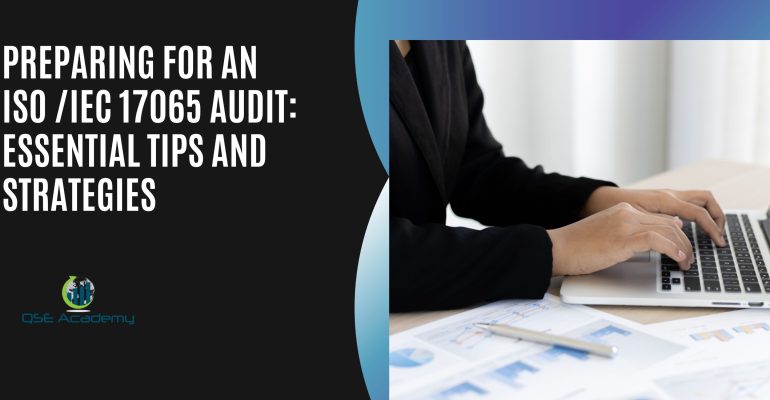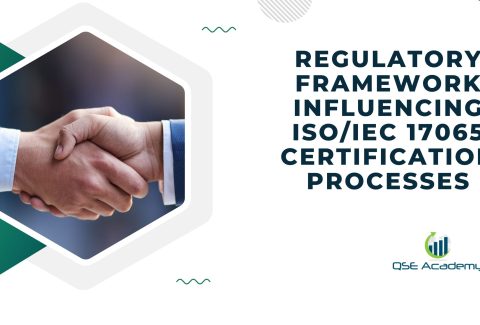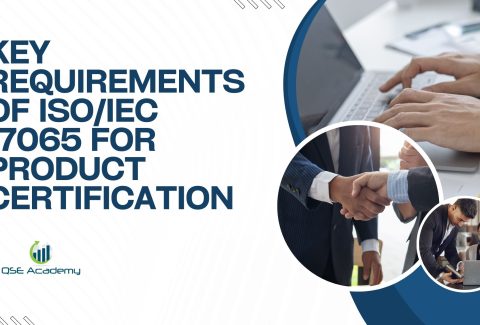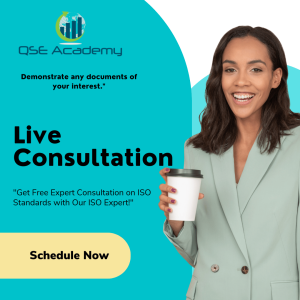Preparing for an ISO/IEC 17065 Audit: Essential Tips and Strategies
Preparing for an ISO/IEC 17065 Audit: Essential Tips and Strategies
Let’s be honest—audits can feel overwhelming. Whether it’s your first ISO/IEC 17065 audit or just another round of surveillance checks, the process can bring a mix of anxiety and urgency. After all, auditors will be reviewing everything—from your certification processes to your decision-making procedures, documentation, and impartiality policies. But here’s the good news: with the right approach, ISO 17065 audit preparation doesn’t have to be stressful.
A well-prepared certification body doesn’t just “pass” an audit—it demonstrates confidence, transparency, and efficiency. And that’s exactly what we’ll help you achieve in this guide.
So, where do you start? By focusing on ISO 17065 audit preparation tips that ensure your documentation is organized, your team is ready, and your processes align with ISO 17065 standards. The key is not waiting until the last minute but instead following a structured, proactive approach that makes audits feel like a natural part of your operations rather than a dreaded event.
In this guide, we’ll break down practical, no-nonsense ISO 17065 audit preparation tips to help you:
✔ Get your documentation in order so auditors can easily review your records.
✔ Conduct an internal review to identify and correct gaps before the audit.
✔ Prepare your team so everyone knows what to expect and how to respond confidently.
✔ Avoid common pitfalls that could cause unnecessary delays or findings.
By the end, you’ll have a clear roadmap for ISO 17065 audit success—one that helps you stay compliant, reduce stress, and build long-term confidence in your certification processes.
Ready to dive in? Let’s get started!
Understanding the ISO/IEC 17065 Audit
Before we dive into the ISO 17065 audit preparation tips, let’s take a step back and understand what an ISO/IEC 17065 audit actually is and why it’s such an important process for certification bodies.
At its core, an ISO 17065 audit is a structured review designed to verify that your certification body is following the required standards. The goal is to ensure that your organization is:
✔ Impartial – Your certification decisions must be fair and free from conflicts of interest.
✔ Competent – Your team should have the right expertise and follow well-defined procedures.
✔ Consistent – Every certification process should follow the same standardized approach.
✔ Transparent – Your documentation, decision-making, and processes should be well-documented and easy to trace.
Auditors don’t just want to see that you have policies in place—they want proof that your ISO 17065 documentation is current, your team is well-trained, and your processes are actually followed in daily operations.
Types of ISO 17065 Audits You May Face
Depending on where your organization is in the certification cycle, you might face different types of audits. Understanding what type of audit you’re preparing for can help you focus your efforts.
Initial Certification Audit
If your certification body is applying for ISO/IEC 17065 accreditation for the first time, you’ll go through a full-scope audit. Auditors will review your entire management system, procedures, impartiality measures, and documentation to ensure you meet ISO 17065 requirements.
✅ What to expect: A deep dive into your processes, interviews with staff, and a thorough review of how you make certification decisions.
✅ Preparation tip: Ensure all ISO 17065 documentation is complete, up to date, and properly structured before the audit begins.
Surveillance Audit
Once accredited, your certification body will undergo regular surveillance audits (usually annually). These audits ensure that you’re continuing to meet ISO 17065 standards and that any previous non-conformities have been resolved.
✅ What to expect: Auditors will focus on key compliance areas, such as how you handle certification decisions, risk management, and complaints.
✅ Preparation tip: Keep your ISO 17065 audit preparation an ongoing process—don’t wait until just before the audit to check your records!
Reassessment Audit
Every few years (typically every five years), certification bodies must undergo a full reassessment audit to maintain their accreditation. This is similar to the initial certification audit, but it also includes a review of how your organization has handled past audits and implemented improvements.
✅ What to expect: A more extensive evaluation of long-term compliance, improvements, and operational effectiveness.
✅ Preparation tip: Maintain an audit history record and track how you’ve corrected past findings—this shows auditors that you take compliance seriously.
What ISO 17065 Auditors Look For
When preparing for an ISO 17065 audit, it helps to know what auditors are focused on. Their job isn’t just to check boxes—it’s to verify that your certification body is operating in line with ISO 17065 principles.
Here’s what they’ll be reviewing:
✔ Impartiality and Objectivity – Your decision-making process must be free from conflicts of interest and outside influence.
✔ Competency of Personnel – Auditors will check that your team has proper training, qualifications, and experience to handle certification activities.
✔ Documented Procedures – Every step of your certification process should be well-documented, consistent, and easy to follow.
✔ Decision-Making Transparency – Your certification approvals, denials, suspensions, and withdrawals should be justified and backed by clear evidence.
✔ Complaint Handling and Appeals – How does your organization manage disputes and challenges to certification decisions? Your complaint-handling process should be fair, timely, and well-recorded.
✔ Internal Audits and Continuous Improvement – Have you been conducting regular internal reviews to check compliance and improve processes?
Knowing what ISO 17065 auditors will focus on helps you target your preparation efforts and ensure you’re fully ready for the review process.
Why Preparation Matters
Audits don’t have to be stressful—but last-minute scrambling makes them much harder than they need to be. By following ISO 17065 audit preparation tips and making compliance an ongoing habit, you can turn audits into an opportunity for improvement rather than a dreaded event.
Up next, we’ll go through the most effective ISO 17065 audit preparation tips, so you’ll know exactly what steps to take to ensure a smooth, successful audit experience.
Let’s keep going!
Key ISO 17065 Audit Preparation Tips
Now that we know what an ISO/IEC 17065 audit involves, it’s time to focus on how to prepare effectively. The last thing you want is to be caught off guard during an audit. With the right approach, you can make the process smooth, stress-free, and even beneficial for your organization.
The following ISO 17065 audit preparation tips will help you get organized, confident, and ready for a successful audit.
Review and Update Documentation
One of the first things auditors will check is your documentation. They want to see proof that your certification processes, decisions, and quality management system align with ISO 17065 requirements.
✅ Check that all required documents are up to date – Your quality manual, policies, and certification procedures should reflect current practices.
✅ Ensure consistency – Avoid having conflicting information in different documents. If one policy says certification decisions take 30 days and another says 45 days, that’s a red flag.
✅ Organize your files for easy access – Auditors don’t want to wait while you search for documents. A well-structured filing system (digital or physical) makes audits go much faster.
🔹 Pro tip: Keep a document checklist based on ISO 17065 audit preparation tips to ensure you have everything in place before the audit.
Conduct a Pre-Audit Internal Review
One of the best ways to avoid surprises during an external audit is to audit yourself first. A pre-audit helps you catch gaps, inconsistencies, or missing records before the real audit happens.
✅ Use an ISO 17065 audit checklist – Go through the key requirements and verify that your processes match what’s documented.
✅ Simulate an external audit – Ask a team member (or an external consultant) to act as an auditor and review your certification procedures and documentation.
✅ Identify and correct non-conformities – If your internal review uncovers missing records, outdated policies, or unclear procedures, fix them before the external audit.
🔹 Pro tip: Treat internal audits as a regular practice, not just something you do right before an external audit. This keeps your organization continuously compliant.
Train Your Team for Audit Readiness
Auditors don’t just review documents—they talk to people. Your staff should be prepared and confident when answering auditor questions about ISO 17065 procedures.
✅ Make sure employees understand their roles – Everyone involved in the certification process should be familiar with what they do, why it matters, and how it aligns with ISO 17065 requirements.
✅ Conduct mock audit interviews – Hold practice sessions where team members answer common auditor questions. This reduces nerves and helps employees respond clearly and professionally.
✅ Encourage a culture of compliance – The best way to prepare for an audit is to ensure compliance is a daily habit, not just a last-minute effort.
🔹 Pro tip: If an employee doesn’t know an answer during an audit, they shouldn’t guess. Instead, they can say, “I’m not sure, but I can show you where we document that information.” This shows auditors that your organization follows structured procedures.
Ensure Certification Decisions Are Transparent and Justifiable
One of the biggest areas of focus in an ISO 17065 audit is how your organization makes certification decisions. Auditors want to see that your process is fair, impartial, and well-documented.
✅ Verify that every certification decision has supporting evidence – If you grant a certification, there should be a clear record of how that decision was made.
✅ Check for impartiality risks – If the same person evaluates and approves a certification, that’s a conflict of interest. Your process should ensure independent decision-making.
✅ Review past certification records – Make sure previous decisions followed proper procedures and were properly documented. Auditors may randomly select cases to review.
🔹 Pro tip: If there was ever a case where certification was denied, ensure the reasons and evidence are clearly recorded. Auditors want to see that your organization follows a fair and structured approach.
Prepare for Auditor Questions and Observations
Auditors will ask questions to verify that your processes align with ISO 17065 requirements. Being prepared with clear, confident answers makes a great impression.
✅ Common auditor questions to prepare for:
- How does your organization ensure impartiality in certification decisions?
- What steps do you take to handle conflicts of interest?
- Can you explain your complaints and appeals process?
- How do you ensure ongoing staff training and competency?
- Can you show me records of certification decisions from the past year?
✅ How to answer confidently:
- Keep responses clear and to the point—avoid adding unnecessary details.
- If you don’t know the answer, show the auditor where the information is documented.
- Demonstrate that your organization follows structured, repeatable procedures.
🔹 Pro tip: During an audit, be honest and professional. Auditors don’t expect perfection—they expect transparency and a commitment to improvement.
Why These ISO 17065 Audit Preparation Tips Matter
A successful audit isn’t just about passing—it’s about showing that your organization operates with integrity, consistency, and professionalism. By following these ISO 17065 audit preparation tips, you’ll be able to:
✔ Avoid last-minute scrambling by keeping documentation organized year-round.
✔ Ensure smooth interactions between auditors and employees.
✔ Reduce the risk of non-conformities that could delay certification or require corrective actions.
✔ Strengthen your certification body’s credibility and operational efficiency.
Up next, we’ll cover common pitfalls to avoid during ISO 17065 audit preparation, so you can sidestep mistakes that could make the process harder than it needs to be.
Let’s keep going!
Avoiding Common Pitfalls in ISO 17065 Audit Preparation
Even with the best ISO 17065 audit preparation tips, it’s easy to fall into some common traps that can make the audit process more stressful than it needs to be. The good news? Most of these pitfalls are completely avoidable if you know what to watch out for.
Let’s go over the most common mistakes certification bodies make during ISO 17065 audit preparation—and, more importantly, how to steer clear of them.
Waiting Until the Last Minute
One of the biggest mistakes organizations make is putting off audit preparation until it’s too late. Scrambling to update documentation, train employees, and organize records just days before an audit is a recipe for stress—and potential non-conformities.
How to avoid this mistake:
✅ Make audit preparation a year-round habit – Keep your ISO 17065 documentation updated as part of daily operations, not just for audits.
✅ Conduct internal audits regularly – A self-check every 3-6 months ensures that you’re always in compliance.
✅ Set calendar reminders – Schedule small review sessions throughout the year so nothing piles up at the last minute.
🔹 Pro tip: Think of ISO 17065 compliance as an ongoing process, not a one-time event. The best-prepared organizations don’t “cram” for audits—they stay ready all year long.
Disorganized or Incomplete Documentation
An auditor’s worst nightmare? A certification body that can’t find key documents or presents inconsistent records. If your paperwork is scattered, outdated, or missing critical details, your audit could be delayed—or worse, flagged for major non-conformities.
How to avoid this mistake:
✅ Keep documents well-structured and labeled – Whether digital or physical, your records should be easy to access.
✅ Cross-check for inconsistencies – Make sure your ISO 17065 documentation is aligned across different policies, procedures, and reports.
✅ Maintain a master document list – Keep a simple checklist of all required documents so nothing is overlooked.
🔹 Pro tip: A well-organized filing system makes your life so much easier—and makes auditors far more confident in your compliance.
Not Addressing Past Non-Conformities
If your last audit revealed non-conformities or improvement recommendations, ignoring them is a major red flag. Auditors will check whether you’ve taken corrective actions—and if you haven’t, it could lead to repeat findings or even jeopardize your accreditation.
How to avoid this mistake:
✅ Create a corrective action plan – For every issue identified in past audits, document how you resolved it and what changes you implemented.
✅ Track progress and follow up – Don’t just fix an issue once—make sure the changes are sustained over time.
✅ Be transparent with auditors – If a problem was identified before, show them what improvements you made to prevent it from happening again.
🔹 Pro tip: Auditors don’t expect perfection, but they do expect continuous improvement. Show them that you take compliance seriously.
Lack of Employee Awareness and Training
Even if your documentation is perfect, an unprepared team can make an audit more difficult than it needs to be. If employees aren’t familiar with ISO 17065 requirements or don’t know how to answer auditor questions, it can raise concerns about how well processes are actually followed.
How to avoid this mistake:
✅ Conduct regular training sessions – Keep your team informed and confident about their roles in the certification process.
✅ Use mock audits – Practice answering common auditor questions so employees know what to expect.
✅ Encourage a culture of compliance – Make sure employees see ISO 17065 compliance as part of their everyday responsibilities, not just something for audits.
🔹 Pro tip: A well-trained team makes a great impression on auditors. They want to see that compliance is embedded in your organization’s culture.
Failing to Demonstrate Impartiality in Decision-Making
One of the biggest concerns in an ISO 17065 audit is whether your certification decisions are impartial and free from conflicts of interest. If auditors find evidence that decisions could be influenced, it could result in serious non-conformities.
How to avoid this mistake:
✅ Clearly document your impartiality policies – Show auditors how your organization avoids conflicts of interest in certification decisions.
✅ Review certification records for transparency – Ensure that every decision is backed by clear, objective evidence.
✅ Keep certification roles separate – Avoid having the same person evaluate and approve a certification—it’s a conflict of interest.
🔹 Pro tip: Auditors want to see that your certification body operates with fairness and integrity. Make sure your records prove it.
Why Avoiding These Pitfalls Matters
A well-prepared certification body isn’t just trying to pass an audit—it’s building a strong, compliant, and credible operation. By avoiding these common mistakes, you can:
✔ Make audits less stressful and more predictable.
✔ Strengthen your ISO 17065 compliance for the long term.
✔ Improve internal efficiency and decision-making.
✔ Show auditors that your organization is well-managed and trustworthy.
The best part? ISO 17065 audit preparation tips don’t just help with audits—they help you run a stronger, more effective certification body every day.
Up next, we’ll go over final ISO 17065 audit preparation tips to ensure you’re not just ready—but fully confident going into your next audit.
Let’s bring it all together!
Final ISO 17065 Audit Preparation Tips for Success
We’ve covered a lot of ground when it comes to ISO 17065 audit preparation tips, but before you head into your next audit, let’s wrap things up with a few final strategies to make sure you’re fully prepared and confident. These last-minute tips will help you approach the audit calm, collected, and ready to impress the auditors.
Keep Documentation Well-Organized and Readily Accessible
If there’s one thing that can frustrate auditors, it’s a messy or confusing documentation system. Your ISO 17065 documentation should be:
✔ Easy to locate – Keep everything in clearly labeled folders (whether digital or physical).
✔ Up to date – Make sure your policies, procedures, and records reflect current practices.
✔ Consistent across all documents – Avoid contradictions that could raise red flags.
A simple audit-ready folder structure might include:
📌 Quality Manual & Procedures – Outlines your certification body’s approach.
📌 Certification Decision Records – Proof of transparent and fair evaluations.
📌 Internal Audit Reports – Shows that you actively monitor and improve processes.
📌 Training & Competency Records – Demonstrates that your team is qualified and well-prepared.
🔹 Pro Tip: If an auditor asks for a document, you should be able to retrieve it within seconds. A well-organized system makes a great impression and keeps the audit flowing smoothly.
Schedule Regular Internal Audits to Stay Prepared Year-Round
One of the best ISO 17065 audit preparation tips is to never stop preparing. Instead of scrambling at the last minute, keep your organization audit-ready year-round with regular internal audits.
✅ Perform internal audits at least once a year – More frequently if processes change or issues arise.
✅ Use mock audits as practice – Simulating a real audit helps employees gain confidence and identify weak areas.
✅ Follow up on past audit findings – If there were non-conformities in a previous audit, show auditors how you took corrective action.
🔹 Pro Tip: Think of internal audits as “practice runs”—the more you do them, the easier the real audit will be.
Create a Culture of Continuous Improvement
A strong certification body doesn’t just meet ISO 17065 requirements—it strives to improve beyond them. Auditors love to see that your organization is actively refining its processes and learning from past audits.
✔ Encourage employee feedback – The people using your processes daily may have valuable improvement ideas.
✔ Track and analyze audit trends – Are the same issues appearing in multiple audits? Address them proactively.
✔ Invest in ongoing training – Keeping your team updated ensures consistent compliance with ISO 17065 standards.
🔹 Pro Tip: Show auditors that you don’t just aim for minimum compliance—you’re committed to excellence.
Why These Final ISO 17065 Audit Preparation Tips Matter
With the right ISO 17065 audit preparation tips, your certification body can approach audits with confidence and ease. Instead of seeing them as stressful compliance checks, you can use them as opportunities to strengthen your processes, improve transparency, and build credibility.
By following these final steps, you’ll ensure that:
✔ Your documentation is complete, well-organized, and easy to access.
✔ Your team is trained and comfortable answering auditor questions.
✔ Your certification decisions are well-documented, transparent, and impartial.
✔ Your organization continuously improves, making each audit easier than the last.
The key to a smooth audit? Preparation, organization, and a proactive mindset.
Conclusion: Be Audit-Ready, Not Audit-Anxious
A successful audit isn’t about rushing to get things in order at the last minute—it’s about being consistently prepared and making compliance a part of your everyday operations.
By following these ISO 17065 audit preparation tips, your certification body can:
✅ Reduce stress and avoid last-minute scrambling.
✅ Make a strong impression with auditors through clear, structured documentation.
✅ Ensure compliance year-round, not just during audits.
✅ Strengthen internal processes and build long-term credibility.
So, take a deep breath, follow these strategies, and approach your ISO 17065 audit with confidence. You’ve got this!
Conclusion: Be Confident in Your ISO 17065 Audit Preparation
Preparing for an audit doesn’t have to feel like a last-minute scramble or an overwhelming task. With the right ISO 17065 audit preparation tips, you can approach the process calm, organized, and fully confident in your certification body’s compliance.
Remember, an ISO 17065 audit isn’t just about passing—it’s about proving that your certification processes are fair, transparent, and well-documented. By focusing on strong preparation and ongoing compliance, you can turn the audit into a positive experience rather than a stressful one.
Key Takeaways from Our ISO 17065 Audit Preparation Tips
✔ Keep documentation up to date and well-organized – Auditors love when records are easy to find and clearly structured.
✔ Conduct regular internal audits – The best way to stay compliant year-round is to make internal reviews part of your routine.
✔ Train your team to handle audits with confidence – Everyone should know their role, key procedures, and how to answer auditor questions.
✔ Be proactive, not reactive – Don’t wait until audit time to check compliance—embed ISO 17065 requirements into daily operations.
✔ Demonstrate continuous improvement – Show auditors that your organization isn’t just meeting standards, but actively working to improve processes.
Final Thoughts: Own Your ISO 17065 Audit Process
Audits don’t have to be intimidating. By using these ISO 17065 audit preparation tips, you’ll be able to approach them with a well-prepared team, structured documentation, and a clear strategy. Instead of seeing the audit as a challenge, think of it as an opportunity to prove your certification body’s credibility and strengthen internal processes.
So, take control of your ISO 17065 audit preparation, stay proactive, and turn audits into a tool for success rather than a source of stress.
Now, are you ready to ace your next audit?
I hold a Master’s degree in Quality Management, and I’ve built my career specializing in the ISO/IEC 17000 series standards, including ISO/IEC 17025, ISO 15189, ISO/IEC 17020, and ISO/IEC 17065. My background includes hands-on experience in accreditation preparation, documentation development, and internal auditing for laboratories and certification bodies. I’ve worked closely with teams in testing, calibration, inspection, and medical laboratories, helping them achieve and maintain compliance with international accreditation requirements. I’ve also received professional training in internal audits for ISO/IEC 17025 and ISO 15189, with practical involvement in managing nonconformities, improving quality systems, and aligning operations with standard requirements. At QSE Academy, I contribute technical content that turns complex accreditation standards into practical, step-by-step guidance for labs and assessors around the world. I’m passionate about supporting quality-driven organizations and making the path to accreditation clear, structured, and achievable.






















